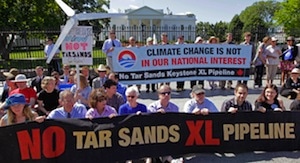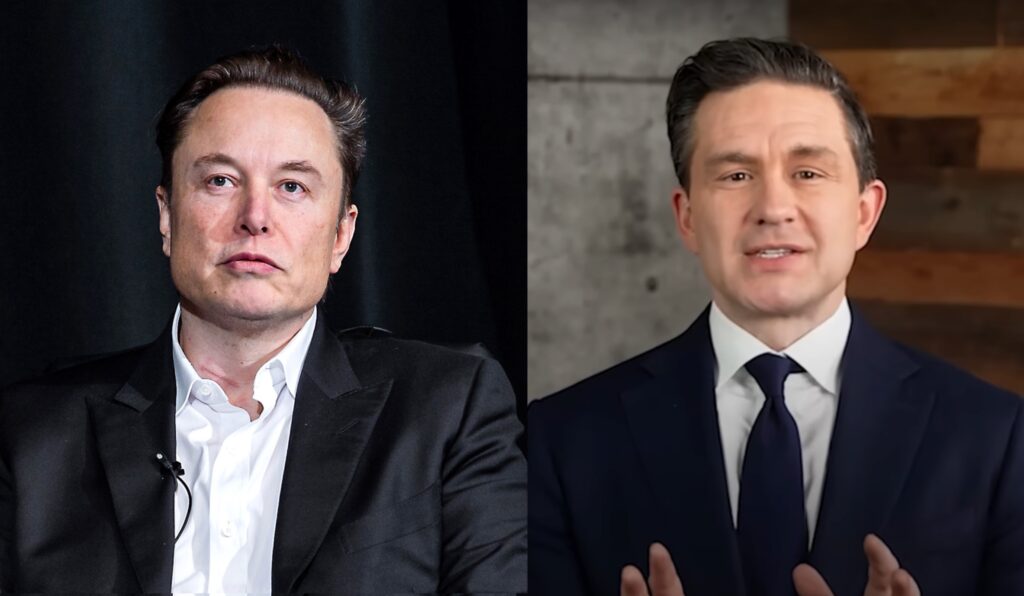This year, a deal between TransCanada and the U.S. government almost allowed one of the most disastrous plans in energy history to win aproval. The deal would have allowed TransCanada to build the Keystone XL pipeline across the U.S. border to carry an exceptionally dirty form of oil from Alberta’s tar sands through several U.S. states to refineries along the Texas gulf coast.
But thanks to some bizarre GOP politicking in the year-end fight over payroll tax cut legislation, the table is set for President Obama to reject this fossil folly. The likely demise of one giant ill-advised pipeline is no small feat, but it doesn’t mean the world can forget about the tar sands, by a long shot. The world is still addicted to oil, and Canada’s fossil-friendly leaders will continue their quest to sell the tar sands bitumen on the global market.
Ever since our founding in 2006, DeSmogBlog has helped spread the word about the dangerous health and climate impacts that the tar sands pose to the environment and the global climate. Over the past year, we focused our research particularly on the dirty tricks employed by the oil industry in an effort to get the Keystone XL pipeline approved.
After Friends of the Earth exposed the fact that TransCanada’s Keystone XL lobbyist Paul Elliott had worked on Hillary Clinton’s 2008 presidential campaign and enjoyed special access with former colleagues, DeSmogBlog revealed further ties between TransCanada lobbyists and the U.S. government. For example:
On the web of lobbyists with connections to Hillary Clinton:
However, the tar sands industry’s use of former Clinton associates to lobby on the controversial project extends beyond Mr. Elliott. DeSmogBlog has uncovered seven other influencers or lobbyists with ties to Clinton and Obama who have lobbied on behalf of tar sands interests for approval of the Keystone XL pipeline.
McKenna Long & Aldridge is one of the key outside firms registered to lobby for TransCanada Pipelines, which paid the McKenna firm at least $190,000 over the last 5 years to lobby on their pipeline issues, including $40,000 in the first half of 2011. McKenna employees donated $41,650 in campaign contributions to Hillary Clinton in 2008, according to the Center for Responsive Politics.
For the full report, see Hillary Clinton’s Keystone XL Crony Lobbyists Problem.
We also helped make public the financial interests that members of Congress had in the approval of the pipeline:
“Rep. Michael McCaul, R-Texas, reported in his 2010 financial disclosure form—the most recent available, filed on May 15, 2011—that he owned Transcanada stock worth between $115,002 and $300,000 (financial disclosure forms ask members to report their assets within broad ranges).”
“Sen. Thad Cochran, R-Miss., reported owning between $15,001 and $51,000 in TransCanada stock in his 2010 financial disclosure; according to his office, the ranking member of the Senate Appropriations Committee sold his stock on January 5, 2011.”
“Rep. Judy Biggert, R-Ill., has held Trans Canada stock since 2004; her most recent disclsosure shows she owns a stake in the company worth between $1,001 and $15,000.”
“Rep. Carolyn McCarthy, D-N.Y.…reported a $798 interest in Trans Canada.”
“U.S. Ambassador to the UN, Susan E. Rice filed that she owned between $250,001 and $500,000 of TransCanada stock.”
But the money didn’t end there:
TransCanada Corp, the company hoping to build the controversial Keystone XL pipeline, spent $540,000 on lobbying in the third quarter of 2011, according to lobbying disclosure records released this week.
In addition to $390,000 reported by Paul Elliott, TransCanada Pipelines, Ltd’s infamous in-house lobbyist, two outside firms lobbied on TransCanada’s behalf to promote the Keystone XL pipeline: Bryan Cave LLP, which reported $120,000 in earnings from TransCanda in quarter three; and McKenna, Long & Aldridge, which was paid $30,000 by TransCanada in the same period.
The industry ties became such a problem for the project that the U.S. inspector general’s office announced an investigation into the matter. And for good reason – the State Department’s ties to TransCanada helped the company escape a more thorough review of the project:
EPA identified a laundry list of omissions in the State Department’s Supplemental Draft Environmental Impact Statement (SDEIS), ranging from lack of adequate consideration for oil spills and impacts on low income and First Nations communities, to lifecycle greenhouse gas emissions and impacts on water and wildlife. They also provided a list of critical areas that need expansion in the Final EIS.
The EPA’s analysis raises considerable concerns about the proposed project that would carry 900,000 barrels of tar sands oil per day from Canada, through Montana, South Dakota, Nebraska, Kansas, Oklahoma, and Texas, and across numerous water bodies including the Yellowstone, Missouri, Neches and Red Rivers, as well as the Ogallala aquifer.
On another front, Rep. Henry Waxman urged Congress to investigate the financial ties to Keystone of the Koch brothers:
Rep. Henry Waxman (D-CA) renewed his request to Reps. Fred Upton (R-MI) and Ed Whitfield (R-KY) that the House Committee on Energy and Commerce investigate Koch Industries’ interest in the Keystone XL pipeline. Rep. Waxman’s letter cites the recent revelations in InsideClimate News that Koch subsidiary Flint Hills Resources Canada LP claimed “a direct and substantial interest” in the Keystone XL in front of Canadian regulators, while the Kochtopus continues to deny any interest publicly.
Koch representatives previously told Rep. Waxman that Keystone XL has “nothing to do with any of our businesses” and that Koch has “no financial interest” in the pipeline.
And there was good reason to believe that the Kochs were among those behind the push to fast-track the pipeline project:
What’s been left out of the fierce debate over the pipeline, according to SolveClimate News, is the prospect that if president Obama okayed the Keystone XL pipeline, he would be handing a major victory and great financial opportunity to Charles and David Koch, his staunchest political enemies and the most powerful opponents of his clean economy agenda.
SolveClimate’s analysis shows that Koch Industries is already responsible for close to 25 percent of the tar sands crude that is imported into the United States, and is well-positioned to cash in big from increased Canadian tar sands imports.
The major talking point behind the push for the pipeline was that it would create much-needed jobs for American workers. But as we and many others pointed out extensively, the job creation claims were completely bogus:
According to The Washington Post, the prospect of job creation – the reason so many people in America support the pipeline – isn’t as rosy as TransCanada would have us believe. In fact, their numbers don’t add up at all.
TransCanada threw out a figure of 20,000 jobs (13,000 construction, 7,000 for suppliers) that would be created directly and indirectly through the pipeline construction process. This is the figure that politicians have used to sell the pipeline to their constituents. But as The Washington Post points out, TransCanada chief executive Russ Girling admits the 20,000 figure is far from honest
In reality, according to the exhaustively researched Cornell report, even the earliest, most modest claims seem unrealistic.
In fact, in Pipe Dreams? Jobs Gained, Jobs Lost by the Construction of Keystone XL, the institute says more jobs could actually be destroyed than created by the pipeline.
As if the industry lobbyist ties and the lies about job creation weren’t enough, there is the glaring observation that the pipeline is just not safe for water supplies and public health:
The Natural Resources Defense Council (NRDC), the Pipeline Safety Trust, the National Wildlife Federation and the Sierra Club jointly published a new report [pdf] which details the likelihood that there will be leaks and major oil spills into waterways along the pipeline’s path.
The report explicitly states how tar sands oil is more corrosive than conventional oil and therefore is a much higher risk to pipeline systems. The report notes that it is:
…More acidic, thick, and sulfuric than conventional crude oil…contains fifteen to twenty times higher acid concentrations than conventional crudes and five to ten times as much sulfur as conventional crudes. It is up to seventy times more viscous than conventional crudes. The additional sulfur can lead to the weakening or embrittlement of pipelines.
Because of its damaging effects to pipeline systems, tar sands oil spills will be more frequent than with conventional oil and as such, more devastating to the health and livelihoods of residents, farms and communities
And who can forget the impact that thousands of protesters rallying in front of the White House had:
The DC police force must have recently put in a big order for plasti-cuffs. The commencement of the Keystone XL pipeline protest, which kicked off this past weekend, saw over 100 arrested in the first two days. But there won’t be time for a donut break yet, as the action is set to continue over the next two weeks with over 2,000 people signed up to get arrested in protest of the Keystone XL tar sands pipeline that would carry the world’s filthiest oil from Canada to the Gulf Coast if approved by the Obama administration.
With people coming in from all around the nation, protesters hope to pressure President Obama to deny the permit needed to build the proposed 1700-mile pipeline from Alberta to the US Gulf Coast. Reports about the supposed safety of the pipeline have proven less than stellar, and TransCanada pipelines have already had 12 spills this year. The administration must make a decision about the pipeline by November 1st, and there is pressure coming from cheerleaders of pollution such as the Chamber of Commerce and Americans for Prosperity, to name a few, for the pipeline to go through.
The Keystone XL pipeline is a perfect example of how direct action and independent media can help expose dirty politics and bring some accountability to those making important decisions about our energy future. Hopefully, more and more issues will meet the same resistance from citizens, causing government officials to rethink their disastrous plans to continue down the dirty energy path.
Subscribe to our newsletter
Stay up to date with DeSmog news and alerts







